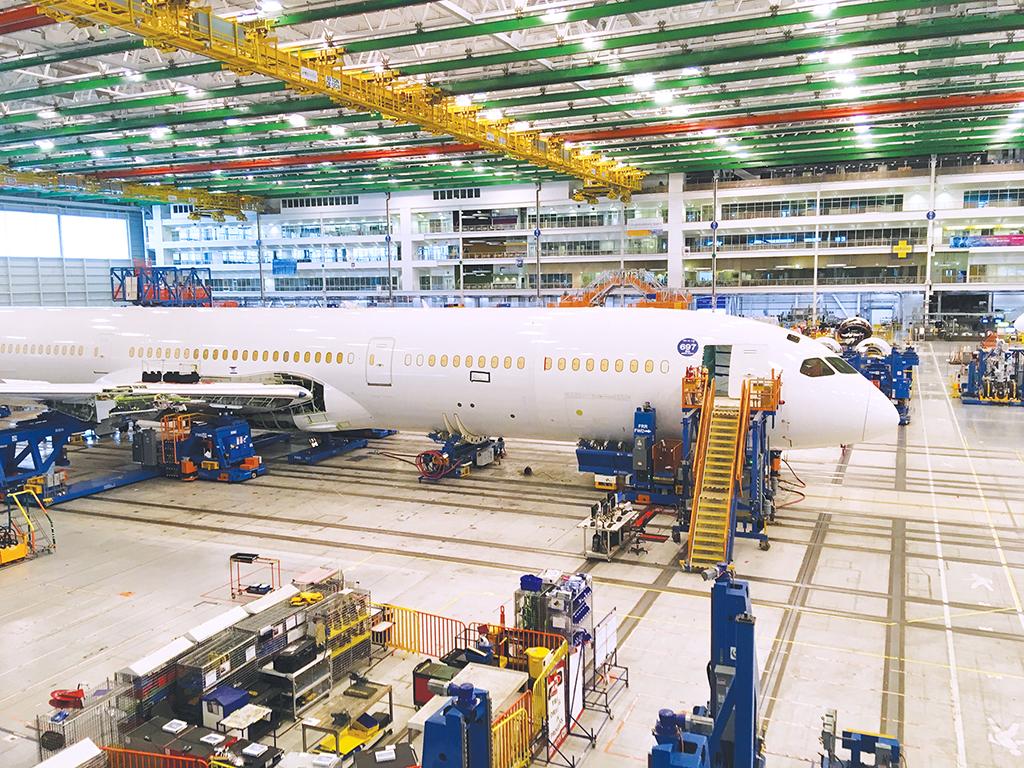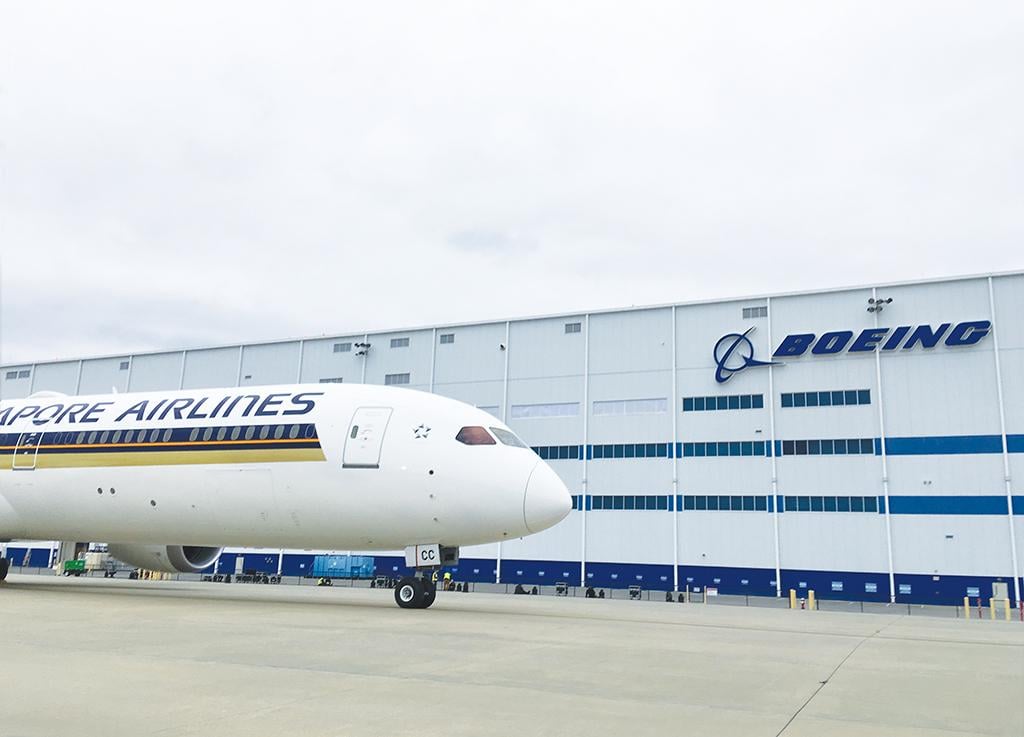787の新たな問題が浮き彫りにする、ボーイング社の品質管理問題 | New 787 Problems Spotlight Boeing’s Quality Issues

ボーイング787に発生している数多くの製造ミスは、メーカーの品質管理能力に対する疑念を増大させており、787プログラムを含む別の製造上の問題に端を発した2015年のFAA(米連邦航空局)との合意に違反する可能性が出てきている。
ボーイング社は787の製造過程で、複合材製の胴体部に2つの一見無関係と思われる問題を発見した。この問題に詳しい関係者によると、より頻発している方の問題にはシム(部品同士の隙間を埋めたり、接合の度合いを調節することで公差に収めるために用いられる部品)が関係しているという。
787の胴体を構成する複合材は、硬化すると非常に硬くなる。硬化した部品と仕上げ形状との間で正確に角度を一致させるのは極めて難しいことから、787の胴体部品を接合する際にはシムが用いられる。ボーイング社は787の一部について、このシムが正しい寸法ではないことを発見した。
2つ目の問題は、機体内側のモールドラインが公差を外れているというものだ。情報提供者によれば、問題の部分はボーイング社が平面度に設定している0.005インチの公差を超えている。
ボーイング社は8機の787にこの両方の欠陥があると判断し、本来耐えられるはずの荷重においても、これらの機体には構造上の問題が生じる可能性があることを認めた。これを受けて同社は、影響を受けた運航会社に対し機体の緊急点検と、おそらく必要になる修理のために運航停止を指示した。修理には1機あたり最低2週間が必要になる見込みだ。この問題は航空ニュースサイト「The Air Current」が最初に報じた。
ボーイング社は、これまで980機が生産された787の内、何機にこれらの問題があるのかについては明言を避けている。問題に詳しい情報提供者は「多くの機体」が影響を受けているとし、別の業界関係者は「数百機」と述べている。ボーイング社はこれら2つの問題が存在し、8機が両方の問題を抱えていることは認めているが、それ以上は言及していない。
同社は「当社は787の後部胴体接合部に2つの製造上の問題があることを確認しており、これらが組み合わさった結果、当社の設計基準を満たしていないことが明らかになった。これらの問題は、当社の品質管理システムの一環として実施されている定期的な監査の中で発見されたものだ」と発表している。また、FAAにも連絡済であり、それぞれの問題の「根本的な原因」を調査していると付け加えた。
本件について、FAAはほとんど言及していない。
「FAAはこの問題を把握しており、ボーイング社と共に対応を進めていく」と発表するに留まっている。
ボーイング社は、いずれの問題も直ちに飛行の安全性に影響を及ぼすようなものではないとしている。
これについて同社は、「それぞれの問題は仕様には合致していないが、荷重条件は満たしているため、(前述の8機以外の)他の機体について直ちに対応する必要はない。当社では運航中の機体データを分析しており、より頻繁な点検や修理といった対策の要否を検討している。また、機体構造の耐用年数に影響を及ぼさないことが明らかになれば、これ以上の措置は必要ないと判断する可能性もある」と述べている。
787の機体重量の半分は炭素繊維強化プラスチックやその他複合材が占めており、これは生産開始時には画期的なことだった。現在稼働している787のうち数百機にこの問題が生じているとすれば、加圧成形式複合材製の機体構造に対してどのような欠陥が生じていくのか、現段階で最も包括的な情報を得られる可能性がある
ある元・材料技術者で非破壊検査の専門家は「アルミは約100年前から(航空機の設計に)用いられてきたため、多くの経験値がある。しかし複合素材に関しては、そのような歴史がない。この先には大きな学習曲線があり、推測はできても確かなことは分からない」と語る。
787が抱えるこの最新の問題は、後部胴体部にある2つの複合素材製セクションの接合部に影響を与える。それらは与圧されるセクション47と、非与圧でエンペナージ(尾翼)部を支えるセクション48だ。いずれのセクションも、2009年にボーイング社がVought Aircraft社から買収したサウスカロライナ州のチャールストン工場で製造されている。これらのセクションは結合された後、2ヶ所ある787の最終組立ラインのいずれかに運ばれる。787の全バリエーションを受け持つチャールストン工場か、787-8と787-9を担当するワシントン州のエヴァレット工場だ。

なお、ボーイング社は過去にも787の機体構造におけるシムの問題を経験している。2014年にFAAが実施した787の設計・認証・製造レビューにおいて、「後部胴体部のシムに関連する不適合の件数は、ボーイング社における他の類似した設計の機体構造部と比較して明らかに多かった。後部胴体部のシム問題は、製造段階およびフルスケール疲労試験の際に明らかになった」と報告されている。ちなみに、このレビューは2014年に123日間の飛行停止をもたらした、運航中の機体におけるリチウムイオン電池のオーバーヒート問題を受けて実施されたものだ。
シムに関する問題のほとんどはデリバリー以前に発見・修正されていたが、5機が「不適切なシムが使用されている可能性がある状態」で運航に入ったことから、ボーイング社はこれが確実に修正されたことを示すためにアラートサービスブリテンを発行した。2014年の報告は、この問題に対して「特定の燃料カップリングの設置要件に明確さと検証が欠けている」と指摘しており、これはボーイング社の品質管理システムに準拠していないと付け加えている。
この新しく広範な製造上の問題は、長期にわたりボーイング社のいくつかのプログラムに対して影響を与えてきた、一連の品質管理問題にも波及している。2015年12月には、FAAが2つの主要な問題(基準に準拠しないファスナーの使用、および燃料タンク不活性システム設置方法に関する説明の期限超過)を調査した後での決定に合意した。同局は2015年の決定を公表した際、これらの問題を調査する過程で「製造時の品質管理上の問題」を含む、他11件の問題も発見されたことを明らかにしている。
そのひとつは、787の燃料供給マニホールドのカップリングが正しく取り付けられていなかったことに関係している。ボーイング社はカップリングアッセンブリに関して3つの問題(Oリング、ロックワイヤー、ファスナーリテイニングリングの不足または不適切な取り付け)を発見した。2012年11月、同社は最初期に製造された38機の787はこれらの問題のうち少なくとも1つは抱えており、31機は3つ全てを抱えていることを明らかにした。また、少なくとも2機の運航中の機体で燃料漏れが発生していたことも判明し、FAAは2012年12月、直ちに有効な耐空性改善通報(AD)を発行した。
合意の中で、ボーイング社は1,200万ドル(FAAの提示額の半額)を投じて、一連のプロセス改善に取り組むことに同意した。その中には、安全管理システムを用いて「継続的な改善を積極的に進め、不適切な状態を修正すること」という文言が含まれている。また、Boeing Commercial Airplanes(BCA)部門に対し「プロセスや設計変更の影響を受けたアッセンブリの取り付けが、引き続き型式設計に適合することを確実にするため、プロセスの改善を実施する」ことを要求している。
この合意の「履行期間」は2021年1月までとなっている。2017年にThe Seattle Times紙による情報公開請求を受けて明らかにされた合意文書には「BCAがこの合意に示された約束を果たさなかった場合、BCAは最大2,400万ドルの追加民事罰の対象となることにBCAおよびFAAは同意する」と記載されている。

ボーイング社の787に関する最新の問題は、同社がKC-46空中給油機と737MAXの品質管理問題に取り組んでいる最中に発生したものだ。いずれも、完成機の内部に工具の置き忘れや異物(FOD)が残されているケースが多発しているというもので、疑念や懸念を招いている。
通常の生産工程と臨時の修正作業、いずれにおいてもFODの問題が発生していることから、米空軍は767の派生型であるKC-46の受け取りを何度も停止してきた。FODは本プログラムの進行を妨げてきたいくつかの理由のひとつだ。
ボーイング社はここ数ヶ月、737MAXの燃料タンク周りで頻発しているFOD問題に対処するため、737の生産ラインに変更を加えた。同機は、5ヶ月で2回の墜落死亡事故を招いた設計および訓練法を修正するために2019年3月から飛行停止となっており、今年初めには生産も一時停止されていた。
737MAXの事故と長期にわたる飛行停止により、ボーイング社は安全性への懸念を経営上の最優先事項に引き上げ、機体が設計通りに製造されることを目的とした、一連の組織変更を実施することとなった。その中でも特に強調されている点は、エンジニアを事業部門から切り離し、一本化されたリーダーシップの下に集約することで、彼らに影響力を持たせることだ(多くは彼らの手に影響力を「戻す」、と表現するだろう)。
7月に、同社のCEO・David Calhoun氏は「安全性を重視した、単一のエンジニアリング部門を全社の軸とする今回の組織変更は、彼らに全社的な改善を進めるための権限を持たせることになると確信している」とAviation Weekに対し語った。彼はこの刷新されたアプローチを用いることで、社内の適切な関係者が「問題に対処するのではなく、問題を先取りするための主体性と視野を持つことができる」と信じている
以上は、Sean BroderickとGuy NorrisがAviation Week & Space Technology誌いた記事です。Aviation Week Intelligence Network (AWIN) のメンバーシップにご登録いただくと、開発プログラムやフリートの情報、会社や連絡先データベースへのアクセスが可能になり、新たなビジネスの発見やマーケット動向を把握することができます。貴社向けにカスタマイズされた製品デモをリクエスト。
Production mistakes on scores of Boeing 787s will intensify scrutiny of the manufacturer’s quality-control capability and could place it in violation of a 2015 agreement with the FAA triggered by other manufacturing problems, including some on the 787 program.
Boeing has discovered two seemingly unrelated defects introduced in composite fuselage sections during 787 production. A source with knowledge of the issues confirms the more prevalent issue involves shims, or material added during assembly to fill gaps between structures or adjust how pieces fit together to ensure tolerances are met.
The composite material that makes up the 787 fuselage is extremely stiff when cured. Achieving the correct corner angle between the cured part and final shape is hard to control, so shimming is used to make parts of the 787 fuselage sections mate together. In some 787s, Boeing found the shims are not the correct size.
The second defect is an out-of-tolerance problem with the fuselage’s inner mold line. The defect areas exceed Boeing’s 0.005-in. tolerance limit for flatness, the source says.
Boeing determined eight 787s have both defects, which together make those aircraft susceptible to structural failure at loads they should be able to withstand. This prompted Boeing to tell affected operators to ground the aircraft for immediate inspection and likely repairs that will take at least two weeks per airframe. The production issues were first reported by The Air Current.
The manufacturer declines to say how many of the 980 787s built so far have one of the two defects. The source with knowledge of the issue confirms that “many” airframes are affected, while a second industry source says the figure is “several hundred.” Boeing acknowledges there are two separate issues but declines to discuss their scope beyond acknowledging that eight aircraft have both.
“Boeing has identified two distinct manufacturing issues in the join of certain 787 aft body fuselage sections, which, in combination, result in a condition that does not meet our design standards,” the company says. The issues were discovered during a “regular” production-system audit “as part of our quality management system,” Boeing says, adding that it informed the FAA and is working to determine each issue’s “root cause.”
The agency has said little publicly.
“The FAA is aware of the matter and continues to engage with Boeing,” an agency statement says.
Neither problem on its own creates an immediate safety-of-flight issue, Boeing says.
“Individually, these issues, while not up to specifications, still meet limit load conditions. No immediate action is required for the rest of the fleet,” the manufacturer says. “We are analyzing data on the in-service fleet to determine if action is required, potentially including more frequent inspection or rework. It could also be determined that no further action is required if the condition is found to not impact the longevity of the structure.”
Half the 787’s airframe by weight consists of carbon-fiber-reinforced plastic and other composites, which was groundbreaking at the time it entered production. Known issues in a few hundred 787 fuselages in service could provide some of the most comprehensive information to date on how defects progress in pressurized composite airframe structures.
“Aluminum has been around [in airplane design] for 100 years,” one veteran materials engineer and nondestructive testing expert says. “We have a lot of experience with it. Composite structures—we don’t have that history. There’s a big learning curve . . . on these airframes. We can speculate, but we don’t know for sure.”
The latest 787 defects affect the join between the 787’s two composite aft fuselage sections, known as Section 47, which is pressurized, and Section 48, which is unpressurized and supports the empennage, or tail, section. Both sections are made in Boeing’s Charleston, South Carolina, manufacturing facility, which it purchased from Vought Aircraft in 2009. The sections are then joined and moved to one of the two 787 final assembly lines—either in Charleston, which assembles all 787 variants, or in Everett, Washington, which assembles 787-8s and 787-9s.

Boeing has dealt with 787 fuselage-shimming problems in the past. A 2014 FAA review of 787 design, certification and manufacturing states that Boeing “identified a significantly higher number of nonconformances related to shimming as compared to other fuselage sections” with similar design features. “Aft fuselage shimming issues were identified in production and in the full-scale fatigue test,” explains the report, prompted by overheating incidents of in-service lithium-ion batteries that led to the fleet’s 123-day grounding in 2014.
Although most of the shim problems were found and corrected before delivery, five aircraft entered service with “potentially discrepant shims,” leading Boeing to issue an alert service bulletin to ensure they were fixed. The 2014 report cited “a lack of clarity and verification for certain fuel coupling installation requirements” for the problems, adding that they did not comply with Boeing’s quality management system.
Word of new, extensive production issues expands on a long-running series of quality-control deficiencies that have affected several Boeing aircraft programs. In December 2015, Boeing and the FAA agreed to a settlement after the agency dug into two main issues—using noncompliant fasteners and missing deadlines for providing instructions on the installation of fuel tank inerting systems. During the FAA’s probe of those issues, 11 others came to light, including some “production quality-control problems,” the agency said in its 2015 announcement of the settlement.
One issue involved incorrectly installed 787 engine fuel feed manifold couplings. Boeing found three problems with coupling assemblies—incorrectly installed or missing O-rings, lock wires and fastener retaining rings. In November 2012, Boeing revealed that 38 of the first 787s built had at least one of the flaws, and 31 had all three. Fuel leaks on at least two in-service aircraft were traced to the problem, prompting the FAA to issue an immediately effective airworthiness directive in December 2012.
Under the settlement agreement, Boeing agreed to pay $12 million—half of what the FAA proposed—and commit to a series of process improvements. Among them was using a safety management system to “proactively seek continual process improvements and correct undesired conditions,” the agreement says. It also requires Boeing Commercial Airplanes (BCA) to “implement improvements to processes to ensure that assembly installations that have been affected by process or design changes continue to conform to type design.”
The agreement’s “performance period” lasts through January 2021. “In the event that BCA does not meet its commitments under this agreement, BCA and the FAA agree that BCA shall be subject to additional civil penalties up to $24 million,” states the agreement, made public following a 2017 Freedom of Information Act request by The Seattle Times.

Boeing’s latest 787 problems come as it grapples with ongoing quality control issues on its KC-46 tanker and 737 MAX programs. In both cases, numerous instances of tools and other foreign object debris (FOD) left inside completed aircraft have drawn scrutiny and concern.
The U.S. Air Force has halted deliveries of the 767-derivative KC-46 multiple times due to FOD discovered during both routine production and nonroutine rework. The FOD issue is one of several that has hampered the program.
Boeing in recent months made changes to its 737 production line to combat rampant FOD issues discovered in 737 MAX fuel tanks. The model has been grounded since March 2019 to correct design- and training-related shortcomings linked to two fatal accidents in five months, and production was briefly paused earlier this year.
The fallout from the MAX accidents and prolonged grounding have prompted Boeing to make a series of organizational changes aimed at elevating safety concerns to the top of the company and ensuring aircraft are built as designed. One emphasis is granting—many would say returning—more influence to engineers, in part by reorganizing them out of business units and under one line of leadership.
“I believe that the alignment of our company—the centerpiece being the [single] engineering function with its eye on safety—will have the authority and the charter” to drive across-the-board improvements, CEO David Calhoun told Aviation Week in July. The Boeing boss is confident the revamped approach gives the right internal stakeholders “the ownership and the visibility to get ahead of issues, as opposed to catching up to them.”
